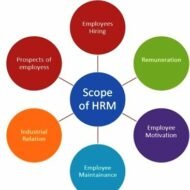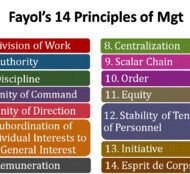Posted by Managementguru in Business Management, Human Resource, Organisational behaviour, Principles of Management
on Mar 13th, 2014 | 0 comments

Scope and Characteristics of HRM 1. Personnel aspect: concerned with manpower planning, recruitment, selection, placement, transfer, promotion, training and development, lay off and retrenchment, remuneration, incentives, productivity, etc.; 2. Welfare aspect; dealing with working conditions and provision of amenities such as canteens, crèches, rest and lunch rooms, housing, transport, medical assistance, education, health, safety, recreation facilities, etc.; and 3. Industrial Relations aspect: the legal part which covers union-management relations, joint consultation, collective bargaining, grievance redress and disciplinary procedures, settlement of disputes, etc. Small Business Management and Marketing Essentials CHARACTERISTICS OF HUMAN RESOURCE MANAGEMENT: 1. It is an art and a science: The art and science of HRM is indeed very complex. HRM is both the art of managing people by recourse to creative and innovative approaches; it is a science as well because of the precision and demanding application of theory that is required. 2. It is pervasive: Development of HRM covers all levels and all categories of people, and management and operational staff. No discrimination is made between any levels or categories. All those who are managers have to perform HRM. It is pervasive also because it is required in every department of the organisation. All kinds of organisations, profit or non-profit making, have to follow HRM. 3. It is a continuous process: First, it is a process as there are number of functions to be performed in a series, beginning with human resource planning to recruitment to selection, to training to performance appraisal. To be specific, the HRM process includes acquisition (HR planning, recruitment, selection, placement, socialisation), development (training and development, and career development), utilisation (job design, motivation, performance appraisal and reward management), and maintenance (labour relations, employee discipline, grievance handling, welfare, and termination). Second, it is continuous, because HRM is a never-ending process. 4. HRM is a service function: HRM is not a profit centre. It serves all other functional departments. But the basic responsibility always lies with the line managers. HRM is a staff function – a facilitator. The HR Manager has line authority only within his own department, but has staff authority as far as other departments are concerned. 5. HRM must be regulation-friendly: The HRM function has to be discharged in a manner that legal dictates are not violated. Equal opportunity and equal pay for all, inclusion of communities in employment, inclusion of tribal’s and farmers in the benefits and non-violation of human rights must be taken care of by the HRM. 6. Interdisciplinary and fast changing: It is encompassing welfare, manpower, personnel management, and keeps close association with employee and industrial relations. It is multi- disciplinary activity utilising knowledge and inputs from psychology, sociology, economics, etc. It is changing itself in accordance with the changing environment. It has travelled from exploitation of workers to treating them as equal partners in the task. 7. Focus on results: HRM is performance oriented. It has its focus on results, rather than on rules. It encourages people to give their 100%. It tries to secure the best from people by winning the whole hearted cooperation. It is a process of bringing people and organization together so that the goals of each are met. It is commitment oriented. 8. People-centred: HRM is about people at work both as individuals and a group. It tries to help employees to develop their potential fully. It comprises people-related functions like hiring, training and development, performance appraisal, working environment, etc. HRM has the responsibility of building human capital. People are vital for achieving organizational goals. Organizational performance depends on the quality of people and employees. 9. Human relations philosophy: HRM is a philosophy and the basic assumption is that employees are human beings and not a factor of production like...

Posted by Managementguru in Business Management, Principles of Management
on Feb 25th, 2014 | 0 comments

Evolution of Management Theory -II MANAGEMENT PROCESS SCHOOL Henri Fayol (1841-1925) Henri Fayol has propagated 14 principles on management which are very popular. 1. Division of labor: He insists on a high degree of specialization in order to improve efficiency. Both managerial and technical works are amenable to specialization which leads to better work with the same efforts. 2. Authority and Responsibility: Authority can be classified into Official and Personal authority, the former needed by a manager to extract work from the subordinates and the latter emanating from the manager’s own intelligence, integrity, experience, personality, knowledge and skills. Responsibility comes along with authority; one who has the authority should also be able to take up responsibility. 3. Discipline: Obedience, diligence, correct attitude and outward mark of respect is the essence of discipline which exists as an unwritten agreement between the management and its employees 4. Unity of Command: A subordinate must receive orders and instructions from one superior only. 5. Unity of Direction: Activities of similar nature should be grouped under one superior so that the efforts could be streamlined towards the common goal. 6. Sub-ordination of individual’s interest to the Common Goal: The personal interests of an individual (like money, recognition etc.) should not be placed before the goal of the organization, which is maximizing production. 7. Remuneration: Fair and equitable remuneration should be provided to employees to ensure better production and satisfaction. 8. Centralization: The concentration and dispersal of authority must be balanced in an organization 9. Scalar Chain: The authority chain from top to bottom should be followed at all times for the purpose of effective communication. 10. Order: Human and material resources should be co-ordinated so as to be in the required place at the required time. 11. Equity: Fairplay, justice and friendliness is what the employees expect of the organization. 12. Stability of Tenure of Personnel: Too much of Job turn over and rotation affect the work in progress and destruct the stability of the work units 13. Initiative: Subordinates must be encouraged to participate in the decision making process to show their initiative. 14. Espirit De Corps: “In union there is strength and so is team work.” Team spirit and a sense of unity and togetherness should be fostered and administered in an organization. Join Over 290+ Other Entrepreneurs Who Are Using This Course. Become An Outsourcing Master In 30 Minutes James D.Mooney and Allen C.Reilay The Line and the Staff Principle: According to this principle, the line authorities get things done while it recognizes the role of staff authority who are experts in providing guidance and advice. The emphasis is on, · Hierarchial structure · Clear decision · Delegation of Authority and Responsibility · Specialization of Tasks · Co-ordination of activities and · Utilization of staff experts A short course designed to help managers select the right person to join their team! Staff Recruitment THE HUMAN RELATIONS SCHOOL The human behaviorists believed in COLLABORATIVE management which is possible when managers are capable of harmonizing the efforts of individuals at all levels of the organization. This concept draws heavily from psychology and social psychology. · Motivation · Leadership · Communication · Training · Participative management · Group dynamics are assigned importance The important contributors are Elton Mayo, Roethlisberger, Mary Parker Follet, Chester I Bernard, Abraham Maslow and Douglas McGregar. THE EMPIRICAL SCHOOL Case study analogy is the best way to understand management is the idea behind this school of thought. The mistakes of managers are converted into rich experiences over a period of time and the findings are transferred to the practitioners in the management profession. The contributors are, · American Management Association · Harvard Business School · Ernest Dale. However, critics feel that this may not be suitable when it...




